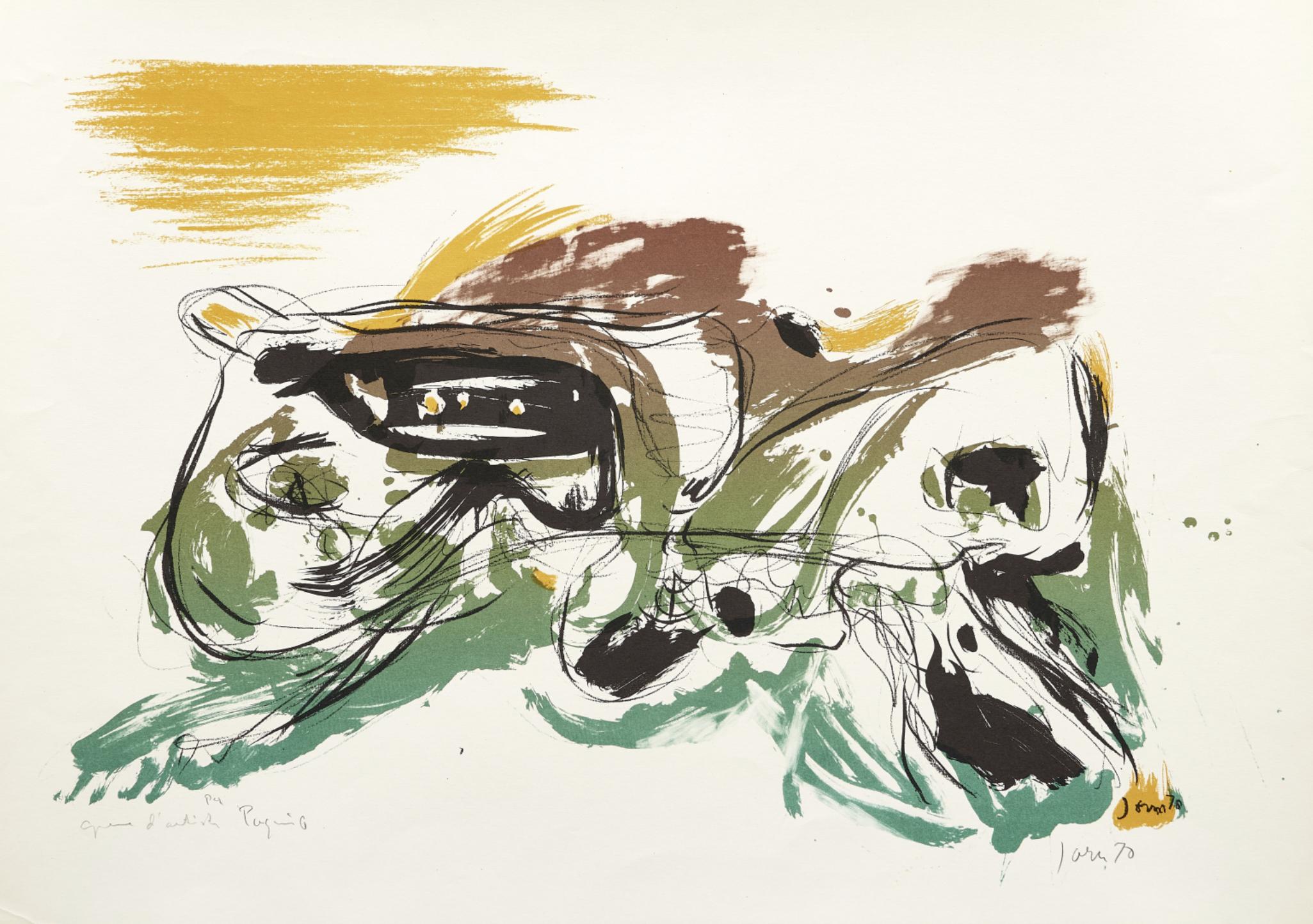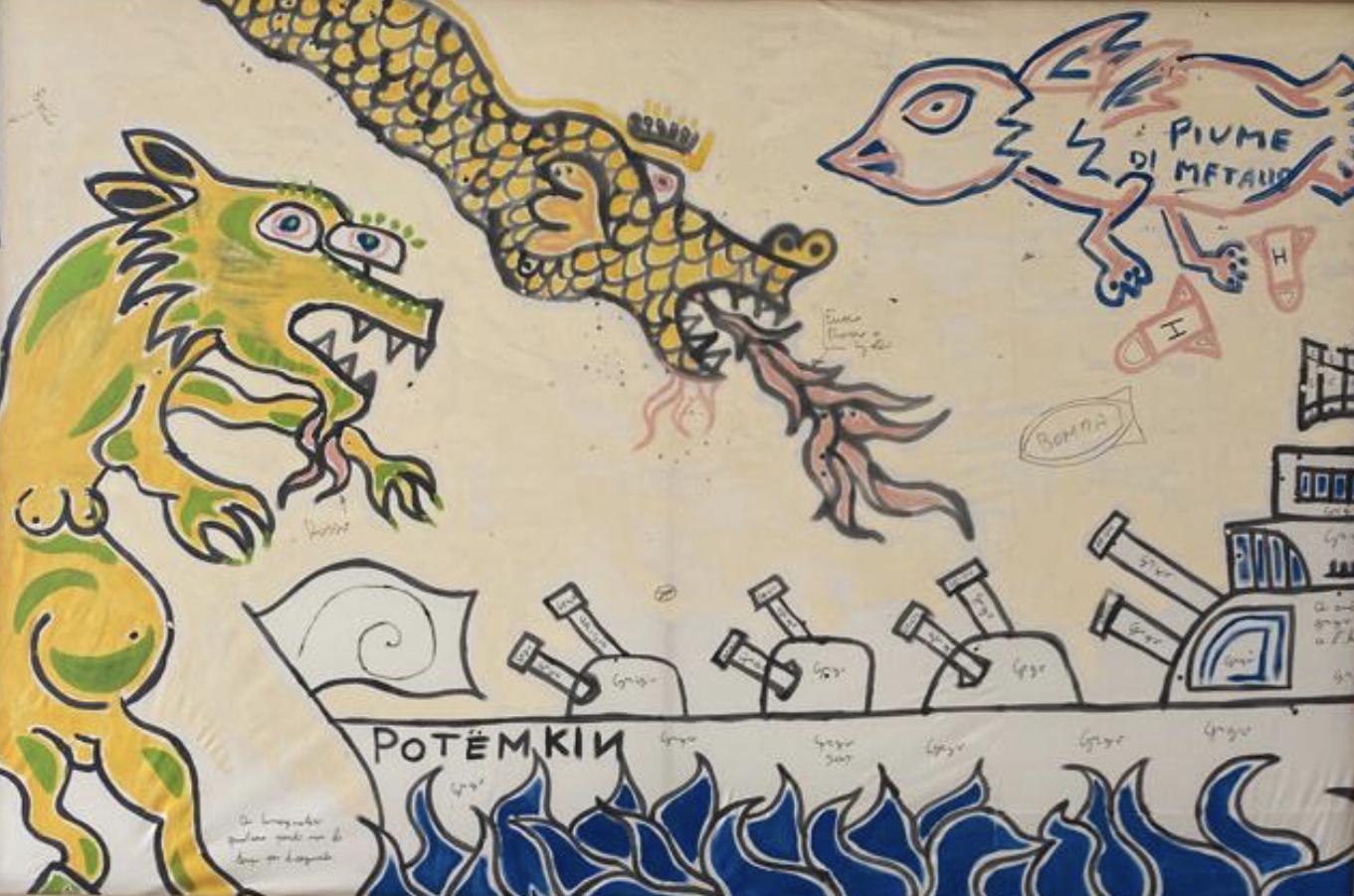
CoBrA ! a Cosio d’Arroscia
dal 12 gennaio al 30 aprile 2023
Sala Consiliare, Comune di Cosio d’Arroscia
In qualche modo l’esperienza dell’internazionale Situazionista, nata nel 1957 a Cosio d’Arroscia, nacque da una breve, intensa e lungimirante avventura artistica conosciuta come C0.Br.A. Il gruppo deve il nome alle città di provenienza dei fondatori, Copenaghen, Brussels, Amsterdam. Asger Jorn, Pierre Alechinsky, Karel Appel e altri tra cui Corneille. Nonostante la breve durata ( dal 1948 al 1951, con solo due mostre all’attivo ) quel modo di fare arte, così “brutale”, immediato e istintivo cambiò il modo stesso di intendere la pittura e la stessa idea di opera artistica. La critica radicale del mercato arrivò fino a cambiare la percezione del rapporto tra opera, artista e collezionista, e pose le basi per giungere qualche anno dopo alla provocatoria pittura industriale venduta a metro del “Situazionista” Pinot Galizio. In realtà gli Artisti del Co.Br.A. furono sperimentatori di nuove tecniche, facendo della riproduzione seriale di un’opera d’arte una esperienza non solo legata alla necessità di rendere l’accesso all’arte più economico ( e quindi più “democratico) . Le opere vennero “pensate” per essere riprodotte con tecniche di stampa particolari, spesso rese di fatto uniche con interventi originali e specifici sulle diverse copie, e gli stampatori vennero coinvolti nella creazione artistica. E’ particolarmente significativa in questa ottica l’esperienza dei Fratelli Pozzo di Torino e delle loro Edizioni d’Arte, dirette non a caso da Ezio Gribaudo, Artista poi divenuto Presidente Emerito della Accademia Albertina di Torino. La Prova d’Artista di Asger Jorn del 1970, che esponiamo in questa occasione, proviene da questa esperienza. Anche le altre opere in esposizione. La Prova d’Artista di Karel Appel , iconica nel linguaggio estetico di quel movimento, è stampata su pergamena, mentre la Prova d’Artista di Pierre Alechinsky è realizzata con tecniche diverse, dall’incisione alla fotografia. Certamente ci furono anche Artisti che della serialità dell’opera d’arte fecero un uso più “estetico” e conseguentemente commerciale, come testimonia la litografia di Corneille, ancorché realizzata in una bassa tiratura.
si veda https://www.artonweb.it/artemoderna/artepostbellica/articolo2.htm
 Giuliano Arnaldi per
Giuliano Arnaldi per
“ Asger Jorn: dipingere con la tipografia”
La testimonianza di Ezio Gribaudo
“ Ho conosciuto Asger Jorn nei primi anni sessanta, durante la preparazione di un volume che ho stampato alla Fratelli Pozzo per Noel Arnaud, La langue verte et la cuite, edito da Jean-Jacques Pauvert. Il libro fu costruito sui tavoli del montaggio, dove si decorarono le lingue, si scelsero e ritagliarono le immagini; non fu preparata una vera e propria maquette, ma si procedette n una mise en page a più mani. Jorn lavorò una settimana. Fino a sera inoltrata dormendo su un lettino di fortuna in infermeria; capiva di avere a disposizione un parco macchine speciale e mi fu sempre grato di avergli dato l’opportunità di dipingere con la tipografia Jorn amava molto la tipografia, l’odore degli inchiostri e dei piombi, dei cliche e dei fani; gli piaceva lavorare direttamente sulle lastre e si cimentava a realizzare opere sperimentali di grafica di grande formato su cui interveniva personalmente di inchiostri e caratteri tipografici. Proprio per la Fratelli Pozzo realizzò la litografia più grande della sua carriera (200 x 140 cm). Jorn amava la parte più creativa e, come se si fosse trovato nel proprio atelier, riuscivamo a dar vita a un lavoro collettivo con i cromisti e le altre maestranze. Ho realizzato con lui due volumi, il primo nel 1970, Jorn a Cuba, testimonianza del suo lavoro svolto a L’Avana su invito del governo cubano nel 1968 che risponde, da un lato, all’idea dell’impegno sociale dell’autore e, dall’altro, ai legami internazionali anche con altri artisti, per esempio Wifredo Lam. Il secondo, Le jardin d’Albisola, è uscito postumo nel 1974 e documenta le ceramiche che l‘artista danese realizzava appunto in questo luogo della Liguria, ora diventato Museo.”

Testimonianza di Ezio Gribaudo.
Si ringrazia la dott.ssa CATERINA FOSSATI
Alla 52 Biennale di Venezia, 2007
da sx Ezio
Gribaudo, Mailk
Sidibè ( Leone d’oro di quell’anno)
Monique Barbier
Mueller, Vittorio
Sgarbi e Giuliano Arnaldi
Pierre Alechinsky - Comme à la maison, 1974. Incisione originale all'acquaforte con collotipia e litografia in colori su carta velina. Firmata a matita e numerata X/XV HC. Pubblicato da Yves Rivière, Parigi, 1974. Incisioni stampate da L'Atelier Moret, Parigi, collotipie e litografie stampate da L'Imperimerie Arte, Parigi. 49,2 x 57,2 cm

Pierre Alechinsky - Comme à la maison, 1974 Original etching with collotype and lithograph in colors on wove paper. Signed in pencil and numbered X / XV HC. Published by Yves Rivière, Paris, 1974. Etchings printed by L'Atelier Moret, Paris, collotypes and lithographs printed by L'Imperimerie Arte, Paris. 49.2 x 57.2 cm
Pierre Alechinsky Comme à la maison, 1974. Eau-forte originale avec phototypie et lithographie en couleurs sur papier vélin. Signée au crayon et numérotée X/XV HC. Editeur : Yves Rivière, Paris, 1974. Gravures imprimées par L'Atelier Moret, Paris, phototypies et lithographies imprimées par l'Imperimerie Arte, Paris. 49,2 x 57,2 cm

CORNEILLE (1922-2010)
SANS TITRE
Lithographie en couleurs sur vélin Numérotée '36/48'

Authentifiée par Natacha van Beverloo, épouse de l'artiste

Tampon sec de Schana B. Gallery
Lithograph in colors on wove paper; numbered '36/48'
and authenticated by Natacha van Beverloo; Schana B. Gallery's dry stamp 57 X 50 CM • 22 1/2 X 19 3/4 IN.
prov. vendita pubblica. Parigi
KAREL APPEL (1921-2006) INCONTRO AL SOLE, 1972


Litografia a colori su pergamena Arches Firmata e giustificata 'E.A.' 76,5 X 58,5 CM • 29 7/8 X 22 7/8 POLLICI.
KAREL APPEL (1921-2006) MEETING IN THE SUN, 1972
Lithographie en couleurs sur vélin d'Arches Signée et justifiée 'E.A.'
Lithograph in colors on Arches wove paper; signed and numbered 'E.A.'
76,5 X 58,5 CM • 29 7/8 X 22 7/8 IN.
ASGER JORN 1914-1973

Senza titolo (composizione), 1970
Litografia ed. P.A.
47 x 64 cm
Firmato e datata sia su lastra che a matita al recto in basso a destra, a sinistra dedicata. Tirata a 99 esemplari dalle edizioni d’arte Fratelli Pozzo, Torino.

Regalo di Jorn allo stampatore della Fratelli Pozzo con il quale lavorò a lungo.
reference
"Werkverzeichnis, Druckgrafik", Guy Atkins, Ed. Galerie Van de Loo, Munich, 1976
"Werkverzeichnis der Druckgraphik - Catalogue raisonné of prints", Galerie van de Loo (Munich) et Silkeborg
Kunstmuseum, Silkeborg Kunstmuseum Forlag, 2010
CoBrA! in Cosio d'Arroscia
from 12 January to 30 April 2023
Council Chamber, Municipality of Cosio d'Arroscia
Somehow the experience of the Situationist international, born in 1957 in Cosio d'Arroscia, was born from a short, intense and farsighted artistic adventure known as C0.Br.A. The group owes its name to the cities of origin of the founders, Copenhagen, Brussels, Amsterdam. Asger Jorn, Pierre Alechinsky, Karel Appel and others including Corneille. Despite the short duration (from 1948 to 1951, with only two active exhibitions) that way of making art, so "brutal", immediate and instinctive changed the very way of understanding painting and the same idea of artistic work. The radical critique of the market went so far as to change the perception of the relationship between work, artist and collector, and laid the foundations for arriving a few years later at the provocative industrial painting sold by the meter of the "Situationist" Pinot Galizio. Actually the Artists of the Co.Br.A. they were experimenters of new techniques, making the serial reproduction of a work of art an experience not only linked to the need to make access to art cheaper (and therefore more "democratic"). The works were "designed" to be reproduced with particular printing techniques, often made in fact unique with original and specific interventions on the various copies, and the printers were involved in the artistic creation. In this perspective, the experience of the Pozzo Brothers of Turin and their Art Editions is particularly significant, directed not by chance by Ezio Gribaudo, an artist who later became President Emeritus of the Accademia Albertina in Turin. Asger Jorn's Proof of Artist from 1970, which we are exhibiting on this occasion, comes from this experience. Also the other works on display. Karel Appel's Artist's Proof, iconic in the aesthetic language of that movement, is printed on parchment, while Pierre Alechinsky's Artist's Proof is made with different techniques, from etching to photography. Certainly there were also artists who made a more "aesthetic" and consequently commercial use of the seriality of the work of art, as evidenced by Corneille's lithograph, albeit made in a small edition.
GIULIANO ARNALDI, CURATOR

“ Asger Jorn: painting with typography”
The testimony of Ezio Gribaudo
“ I met Asger Jorn in the early sixties, during the preparation of a volume that I printed at Fratelli Pozzo for Noel Arnaud, La langue verte et la cuite, edited by Jean-Jacques Pauvert. The book was built on the editing tables, where the languages were decorated, the images were chosen and cut out; a real maquette was not prepared, but a multi-handed mise en page proceeded. Jorn worked for a week. Until late in the evening sleeping on a makeshift cot in the infirmary; he understood that he had a special fleet of machines at his disposal and he was always grateful to me for having given him the opportunity to paint with typography. Jorn loved typography very much, the smell of inks and leads, clichés and fans; he liked to work directly on the plates and tried his hand at creating experimental works of large format graphics on which he personally intervened with inks and typographic characters. Precisely for Fratelli Pozzo he created the largest lithograph of his career (200 x 140 cm). Jorn loved the most creative part and, as if he had been in his own atelier, we were able to create a collective work with the chromists and other workers. I made two volumes with him, the first in 1970, Jorn in Cuba, testimony of his work carried out in Havana at the invitation of the Cuban government in 1968 which responds, on the one hand, to the idea of the author's social commitment and , on the other hand, to the international ties also with other artists, for example Wifredo Lam. The second, Le jardin d'Albisola, was published posthumously in 1974 and documents the ceramics that the Danish artist made precisely in this place in Liguria, which has now become a museum."
Testimony of Ezio Gribaudo.
Thanks to Dr. CATERINA FOSSATI
From left to right : Ezio Gribaudo, Malik Sidibè, Monique Barbier-Mueller, Vittorio Sgarbi e Giuliano Arnaldi - Venice , 52 Biennale , 2007

CoBra fu l’inizio di una rivoluzione culturale. Alimentato dalle suggestioni surrealiste, nel brave arco della sua esistenza evocò in potenza tutto il nuovo che sarebbe accaduto in seguito, e che in parte deve ancora accadere. Forma, segno, colore, materia, finalmente liberati dalla “sabbia della maniera” per dirla con Debord, diventarono elementi alfabetici con cui scrivere storie nuove, o meglio le storie di sempre ( vita, morte, amore, odio… ) in modo nuovo. L’alfabeto delle forme liberate dalla ossessione figurativa, la potenza del colore , anticiparono con passione dirompente i grandi temi del nuovo millennio, l’uso sperimentale delle tecniche di stampa diede nuova dignità all’idea stessa di serialità del prodotto artistico. Proseguendo il ragionamento iniziato con l’esposizione di opere di Agenore Fabbri, Rainer Kriester ed Emilio Scanavino abbiamo voluto rendere omaggio alla vivacità di quegli anni, veramente diffusa nel mondo dell’arte e spesso, come nel caso di Gianni Frassati, pesantemente sottovalutata. Il ruolo dei collezionisti fu importante, sia che fossero dotati di importanti risorse economiche oppure condizionati dai costi delle opere d’arte proposte in quel tempo dal mercato. E’ illuminante l’esperienza della Collezione Nobile di Novara, che con rara passione e intuizione raccolse opere di notevole bellezza a costi allora ragionevoli: i Frassati e il Crippa esposti provengono da questa collezione. Abbiamo costruito l’esposizione di Cosio partendo da questa convinzione, inserendo conseguentemente altre forme, altri materiali apparentemente lontani dall’esperienza Co.Br.A. ma in realtà in perfetta sintonia nel dichiarare la potenza evocativa dei linguaggi dell’arte, destinati ad evocare stati di coscienza e non a descrivere la mera realtà. Le connessioni sono anche altre, più dirette e profonde: Asger Jorn fu profondo conoscitore dei linguaggi antichi del Grande Nord, da cui provengono gli occhiali Inuit qui esposti, quasi tutti gli artisti di quel tempo furono istintivamente collezionisti di opere di arte primarie. Alcuni degli artisti più geniali di quel tempo scelsero Cosio d’Arroscia come luogo di nascita di un pensiero nuovo e radicale, destinato prima ad infiammare le piazze d’Europa e poi a sedimentare proficuamente nella riflessione culturale di intere generazioni. Che sia la Casa della Comunità Cosiese, il Palazzo Comunale, il luogo dove quelle passioni rivivono è la SituAzione più adatta che si potesse immaginare.
Cosio d’Arroscia, 12 gennaio 2023
CoBra was the beginning of a cultural revolution. Fueled by surrealist suggestions, in the short span of his existence he potentially evoked all the new that would happen later, and which in part has yet to happen. Shape, sign, color, matter, finally freed from the "sand of manner" to quote Debord, became alphabetic elements with which to write new stories, or rather the stories of all time (life, death, love, hate...) in a new way. The alphabet of forms freed from figurative obsession, the power of color, anticipated the great themes of the new millennium with explosive passion, the experimental use of printing techniques gave new dignity to the very idea of seriality of the artistic product. Continuing the reasoning begun with the exhibition of works by Agenore Fabbri, Rainer Kriester and Emilio Scanavino, we wanted to pay homage to the vivacity of those years, truly widespread in the art world and often, as in the case of Gianni Frassati, heavily underestimated. The role of collectors was important, whether they were endowed with significant economic resources or conditioned by the costs of the works of art offered by the market at that time. The experience of the Nobile Collection of Novara is illuminating, which with rare passion and intuition collected works of remarkable beauty at then reasonable costs: the Frassatis and Crippas on display come from this collection. We built the Cosio exhibition starting from this conviction, consequently inserting other forms, other materials apparently distant from the Co.Br.A experience. but in reality in perfect harmony in declaring the evocative power of the languages of art, intended to evoke states of consciousness and not to describe mere reality. The connections are also other, more direct and profound: Asger Jorn was a profound connoisseur of the ancient languages of the Far North, from which the Inuit glasses exhibited here come, almost all the artists of that time were instinctively collectors of primary works of art. Some of the most brilliant artists of that time chose Cosio d'Arroscia as the birthplace of a new and radical thought, destined first to inflame the squares of Europe and then to settle profitably in the cultural reflection of entire generations. Whether it is the Casa della Comunità Cosiese, the Palazzo Comunale, the place where those passions come to life again, it is the most suitable Situation imaginable.
Cosio d'Arroscia, 12 January 2023
si ringraziano gli Eredi Nobile, la Fondazione VAF, la Galleria Spirali d’arte di Milano, e i collezionisti privati che ci consentono di esporre queste opere.




 IGGAAK, il mono in una fessura
IGGAAK, il mono in una fessura
IGGAAK: Il mondo in una fessura / the world in a slot
Non chiamateli esquimesi, è un termine dispregiativo. Esquimesi significa “fabbricanti di racchette da neve”, e venne loro attribuito dai vicini Algochini . Loro sono Inuit, parola che letteralmente significa “ uomini” , e discendono dagli antichi Thule. Sono pescatori e cacciatori, sono pochi e abitano quella immensa distesa di di bianco che chiamiamo Groenlandia, dove il bagliore accecante del sole che si riflette su ghiaccio e neve crea fastidio e danni alla vista . La funzione degli "Iggaak", “ o “inukhuk” - comunemente chiamati occhiali da neve - e’ garantire una rudimentale ma efficace protezione della retina, e migliorare la visione centrale del cacciatore eliminando la visione periferica. Sono tradizionalmente realizzati in legno galleggiante (soprattutto abete rosso), osso, avorio di tricheco, corna di caribù o, in alcuni casi, erba marina, e tagliati per adattarsi al viso di chi lo indossa. Una o più strette fessure orizzontali sono praticate nella parte anteriore. Gli Yupik li chiamano Nigaugek, ma sono pressoché identici per forma, materiale e funzione: semplici, essenziali e geniali, questi oggetti a volte sono “personalizzati” con iscrizioni che rimandano ad appartenenze claniche.
Le foto provengono da https://www.vintag.es/2021/11/inuits-snow-goggles.html
Don't call them Eskimos, it's a derogatory term. Esquimesi means "snowshoe makers", and was attributed to them by the neighboring Algochini.They are Inuit, a word that literally means "”women”" and descended from the ancient Thule. They are fishermen and hunters, they are few and they inhabit that immense expanse of white we call Greenland, where the blinding glare of the sun that reflects on ice and snow creates annoyance and damage to the eyesight. The function of the "Iggaak", “ or “inukhuk”commonly called snow goggles - is to guarantee a rudimentary but effective protection of the retina, and to improve the central vision of the hunter by eliminating the peripheral vision. They are traditionally made from driftwood (especially spruce), bone, walrus ivory, caribou antler, or, in some cases, sea grass, and trimmed to fit the wearer's face. One or more narrow horizontal slits are made in the front. The Yupik call them Nigaugek, but they are almost identical in shape, material and function: simple, essential and ingenious, these objects are sometimes "personalised" with inscriptions that refer to clan memberships.
IGGAAK, il mono in una fessura
 GIULIANO ARNALDI
GIULIANO ARNALDI
 Roberto CRIPPA, IL VOLO
Tecnica mista su tavola cm 37,5 x 46 provenienza Galleria Baguttino , Milano. Collezione Nobile, Novara
Roberto CRIPPA, IL VOLO
Tecnica mista su tavola cm 37,5 x 46 provenienza Galleria Baguttino , Milano. Collezione Nobile, Novara
Aldo MONDINO, Turcata . 2002 olio su linoleum, cm 40x40 circa

Gianni FRASSATI, Paesaggio Metafisico
1957. Olio su tela cm 50x 70 . Prov. Collezione Nobile, Novara

Gianni FRASSATI. Senza Titolo
1969 olio su tela cm 92x72 Collezione Nobile

 «Iggaak» o «inukhuk». Cultura Inuit, Groenlandia. Osso marino
«Iggaak» o «inukhuk». Cultura Inuit, Groenlandia. Osso marino
Cultura Punu, Gabon. Maschera Okuyi o Mukudji cm 30 legno, caolino, tracce di danni causati da insetti
Conosciuta nella collezione di Robert Duperrier fino dagli anni ’70 del secolo scorso, è passata nelle vendite Loudmer-Poulain ( giugno 1981 ) poi nella collezione di Simone Véliot esposta da Jean Baptiste Bacquard nel 2015 e pubblicata sul catalogo “Une Collection d’Artiste, Simone Veliot”, in seguito nelle vendite Zemanek e Native: Ora a Onzo, ha trovato casa nella Collezione Tribaleglobale.
Punu culture, Gabon, Okuyi or Mukudji mask

30 cm. Wood, kaolin, traces of damage caused by insects
Known in the Robert Duperrier collection since the 1970s, it passed into LoudmerPoulain sales (June 1981) then into the Simone Véliot collection exhibited by Jean Baptiste Bacquard in 2015 and published in the catalog "Une Collection d'Artiste, Simone Veliot ”, later in the sales Zemanek and Native: now she is in Onzo, she has found a home in the Tribaleglobale Collection.
Abelam, Yam-mask
Per gli Abelam il culto di Yam è molto importante, e legato agli antenati totemici. Questa maschera ha un'associazione con un antenato. La maschera viene utilizzata per decorare gli ignami che vengono poi presentati nella casa degli uomini. Dopo questa presentazione gli ignami verranno scambiati con altri villaggi. La persona che ha coltivato l'igname non vuole mangiare il proprio raccolto perché sente di mangiare il proprio figlio.
For the Abelam are mythical ancestors and the yamscult very important. This mask has an association with an ancestor. The mask is used to decorate the yams and are then presented in the men’s house. After this presentation the yams will be exchanged with other villages. The person who has grown the yam doesn’t want to eat its own crop because it feels to him that he eats his own child.

Indonesia, east Giava. maschera da teatro raffigurante un mangiatore di betel cm 20x17 .prov. Collezione Berger, Milano

 Nepal, maschera rituale . Legno cm 25,5. pro. Collezione Berger, Milano
Nepal, maschera rituale . Legno cm 25,5. pro. Collezione Berger, Milano
In occasione dell’evento “ Co.Br.A. a Cosio ! l’opera di Filippo Biagioli “L’Art Brut contro la sezione aurea”, tecnica mista su tela cm 200x300 trova la sua collocazione definitiva nella Sala Consiliare di Cosio d’Arroscia. L’opera è stata donata alla Comunità Cosiese dall’Artista.

da sx il Presidente della Associazione SituAzioni Tribaliglobali, Emilio Grollero, il Sindaco di Cosio d’Arroscia Mauro Parodi e il Curatore degli Eventi, Giuliano Arnaldi


